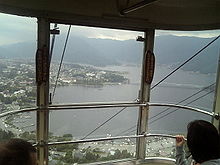- Tenjō-Yama Park Mt. Kachi Kachi Ropeway
-
The Tenjō-Yama Park Mt. Kachi Kachi Ropeway (天上山公園カチカチ山ロープウェイ Tenjōyama Kōen Kachikachiyama Rōpuwei), officially the Lake Kawaguchi Mt. Tenjō Ropeway (河口湖天上山ロープウェイ Kawaguchiko Tenjōyama Rōpuwei), is Japanese aerial lift line in Fujikawaguchiko, Yamanashi, operated by Fuji Kyūkō. Opened in 1959, the line climbs Mount Tenjō from the shores of Lake Kawaguchi, one of the Fuji Five Lakes. The line name comes from Kachi-kachi Yama (lit. "Mt. Kachikachi"), a folktale which took place on the mountain. The observatory has a view of the lake, as well as Aokigahara forest, and Mount Fuji.
Basic data
- System: Aerial tramway, 3 cables
- Cable length: 460 m (1,509 ft)
- Vertical interval: 219 m (719 ft)
- Maximum gradient: 34°07′
- Operational speed: 3.4 m/s
- Passenger capacity per a cabin: 36
- Cabins: 2
- Stations: 2
- Duration of one-way trip: 3 minutes
See also
External links
- (Japanese) Official website
Transit in the Hakone, Izu Peninsula, and Mount Fuji area Izuhakone Railway Group Daiyūzan Line · Hakone Komagatake Ropeway · Jukkokutōge Cable Car · Lake Ashi Excursion Ship · Sunzu LineOdakyū Group JR Lines Others Atami Ropeway · Fujikyū Line · Izu Kyūkō Line · Katsuragiyama Ropeway · Mt. Kachi Kachi Ropeway · Shimoda Ropeway · Fujikyu Kawaguchiko RopewayMiscellaneous Categories:- Japanese cable line stubs
- Aerial tramways in Japan
- Visitor attractions in Yamanashi Prefecture
Wikimedia Foundation. 2010.

